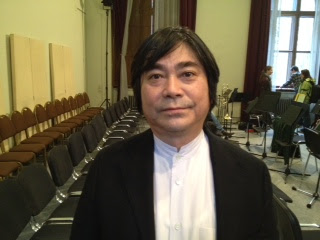Rudolfinum
April 1
 |
| A composer on a humanitarian mission. |
Japanese composer Susumu Ueda was not in his hometown of Kobe in January 1995, when the Great Hanshin earthquake erupted. But the event touched him deeply, and ultimately provided inspiration for a contemporary Requiem titled Never Forget the Day and You.
“We lost 6,434 precious lives, and more than 50,000 people were injured,” says Ueda. “I composed this music as a memorial to those victims, and to give hope to the survivors.”
Prague audiences will have a chance to hear Uedaʼs Requiem at the Rudolfinum on Sunday, when he conducts a performance of it by the Prague Philharmonia. The orchestra will be accompanied by the Kühn Mixed Choir, along with two choirs and five soloists from Japan. In the first half of the concert, Koji Kawamoto, the chief conductor and music director of the Pilsen Philharmonic, will conduct pieces by J.S. Bach and Mozart.
Though it was inspired by the Kobe disaster, Uedaʼs Requiem quickly took on larger dimensions in disaster-plagued Japan. Since its premier in Kobe in 2010, the piece has been performed 15 times throughout the country. “The music has been spreading to other areas struck by natural disasters, even the site of the Great East Japan earthquake last year,” Ueda says.
Better-known in the West by the shorthand term “Fukushima,” that earthquake and the devastating tsunami it triggered created a wave of sympathy and support around the world, including Prague, where a number of charitable activities were held to help the victims. Sundayʼs concert is an acknowledgment and continuation of that effort.
.JPG) |
| A full slate of soloists from Japan. |
“As a Japanese, I am extremely appreciative and grateful that so many musicians in Prague gave benefit concerts after the earthquake,” Ueda says. “But a year later, many people at the site are still suffering. With prayers from the people in Prague, I would like to deliver a commemoration and offer encouragement to the people in Japan.”
Ueda arrived in Prague early to record Never Forget the Day and You with the Philharmonia and the Kühn and Japanese singers. The work is in ten parts, with text in Latin. As in a classic Requiem, six sections of text were taken from the liturgy for a Catholic Mass. The other four sections are translations of original poems by Ueda, who kept the score relatively simple. “I used a very accessible music vocabulary for composing this piece,” he says.
With help from the Japanese government, Ueda is paying for the hall, the orchestra and the Kühn Choir himself. All the Japanese singers paid their own plane fare, and are performing for free, as is Kawamoto. Admission to the concert is also free. Donation boxes will be set up throughout the hall, with the proceeds going to disaster victims in Japan.
“I feel honored to deliver my Requiem with a wonderful orchestra and chorus,” Ueda says. “I hope many people will come to share our music.”
Free tickets to the concert will be available at the Rudolfinum box office starting one hour before the performance. For more details on the program:
To hear a sampling of the Requiem: http://www.youtube.com/watch?v=5NAziSZdaII







